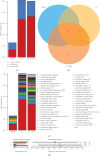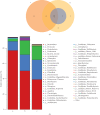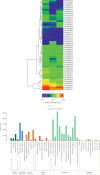Quyushengxin Formula Causes Differences in Bacterial and Phage Composition in Ulcerative Colitis Patients
- PMID: 32454865
- PMCID: PMC7240791
- DOI: 10.1155/2020/5859023
Quyushengxin Formula Causes Differences in Bacterial and Phage Composition in Ulcerative Colitis Patients
Abstract
Background: Ulcerative colitis (UC) is a chronic inflammatory disease that affects the colon and the rectum. Recently, some studies have shown that microorganisms in the gut play important roles in many chronic diseases such as UC.
Methods: To study the candidate viruses and bacteria involved in UC and to investigate the therapeutic mechanism of Quyushengxin formula (QYSX) in UC patients, metagenomic sequencing was performed on the feces from healthy donors and UC patients before and after QYSX treatment.
Results: QYSX improved the symptoms of UC. In all participants, Caudovirales and Herpesvirales were the most dominant viruses. The abundance of Caudovirales in UC patients was significantly higher than that in the normal controls, while QYSX restored Caudovirales abundance. Furthermore, the abundance of crAssphage was enhanced in UC patients compared with the normal control, while the diversity was then decreased after QYSX treatment. However, there was no significant difference (P > 0.05). Additionally, other non-crAssphage bacteriophages including phiST, SP-10, and phi17:2 were higher in UC patients and QYSX decreased these viruses, while the trends of MED4-213, P-HM1, and P-HM2 were adverse. Interestingly, PhiDP23.1 was only found in UC patients before and after QYSX treatment. In addition, Bifidobacterium, Bacteroidetes, Prevotellaceae, Actinobacteria, and Corynebacteriales were the biomarkers in UC patients after QYSX treatment due to their high abundance. GO terms and KEGG analysis showed that the identified gut microbiome was involved in many biological processes and pathways.
Conclusions: QYSX could regulate disordered gut microbiome and phages, indicating that QYSX has great therapeutic potential for UC.
Copyright © 2020 Haojie Yang et al.
Conflict of interest statement
The authors declare that they have no conflicts of interest.
Figures






Similar articles
-
Enteric Virome and Bacterial Microbiota in Children With Ulcerative Colitis and Crohn Disease.J Pediatr Gastroenterol Nutr. 2019 Jan;68(1):30-36. doi: 10.1097/MPG.0000000000002140. J Pediatr Gastroenterol Nutr. 2019. PMID: 30169455 Free PMC article.
-
Gut mucosal virome alterations in ulcerative colitis.Gut. 2019 Jul;68(7):1169-1179. doi: 10.1136/gutjnl-2018-318131. Epub 2019 Mar 6. Gut. 2019. PMID: 30842211 Free PMC article.
-
Gut microbiota contributes to the distinction between two traditional Chinese medicine syndromes of ulcerative colitis.World J Gastroenterol. 2019 Jul 7;25(25):3242-3255. doi: 10.3748/wjg.v25.i25.3242. World J Gastroenterol. 2019. PMID: 31333315 Free PMC article.
-
Fecal microbiota transplantation for ulcerative colitis.Immunol Med. 2021 Mar;44(1):30-34. doi: 10.1080/25785826.2020.1792040. Epub 2020 Jul 14. Immunol Med. 2021. PMID: 32663072 Review.
-
Enteric microbiota leads to new therapeutic strategies for ulcerative colitis.World J Gastroenterol. 2014 Nov 14;20(42):15657-63. doi: 10.3748/wjg.v20.i42.15657. World J Gastroenterol. 2014. PMID: 25400449 Free PMC article. Review.
Cited by
-
Quyu Shengxin Decoction Alleviates DSS-Induced Ulcerative Colitis in Mice by Suppressing RIP1/RIP3/NLRP3 Signalling.Evid Based Complement Alternat Med. 2021 Aug 20;2021:6682233. doi: 10.1155/2021/6682233. eCollection 2021. Evid Based Complement Alternat Med. 2021. PMID: 34462641 Free PMC article.
-
The Two-Faced Role of crAssphage Subfamilies in Obesity and Metabolic Syndrome: Between Good and Evil.Genes (Basel). 2023 Jan 4;14(1):139. doi: 10.3390/genes14010139. Genes (Basel). 2023. PMID: 36672880 Free PMC article.
-
Antidepressants amitriptyline, fluoxetine, and traditional Chinese medicine Xiaoyaosan caused alterations in gut DNA virome composition and function in rats exposed chronic unpredictable mild stress.Front Microbiol. 2023 Apr 14;14:1132403. doi: 10.3389/fmicb.2023.1132403. eCollection 2023. Front Microbiol. 2023. PMID: 37125190 Free PMC article.
-
Study on the Mechanism of Periplaneta americana Extract to Accelerate Wound Healing after Diabetic Anal Fistula Operation Based on Network Pharmacology.Evid Based Complement Alternat Med. 2021 Mar 9;2021:6659154. doi: 10.1155/2021/6659154. eCollection 2021. Evid Based Complement Alternat Med. 2021. PMID: 33777160 Free PMC article.
-
Lactiplantibacillus plantarum P9 for chronic diarrhea in young adults: a large double-blind, randomized, placebo-controlled trial.Nat Commun. 2024 Aug 9;15(1):6823. doi: 10.1038/s41467-024-51094-2. Nat Commun. 2024. PMID: 39122704 Free PMC article. Clinical Trial.
References
-
- Magro F., Gionchetti P., Eliakim R., et al. Third European evidence-based consensus on diagnosis and management of ulcerative colitis. Part 1: definitions, diagnosis, extra-intestinal manifestations, pregnancy, cancer surveillance, surgery, and ileo-anal pouch disorders. Journal of Crohn’s and Colitis. 2017;11(6):649–670. doi: 10.1093/ecco-jcc/jjx008. - DOI - PubMed
LinkOut - more resources
Full Text Sources

